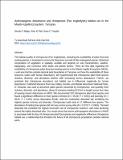| dc.description.abstract | The habitat quality of chimpanzee (Pan troglodytes), including the availability of plant food and nesting species, is important to ensure the long-term survival of this endangered species. Botanical composition of vegetation is spatially variable and depends on soil characteristics, weather, topography, and numerous other biotic and abiotic factors. There are few data regarding the availability of chimpanzee plant food and nesting species in the Masito-Ugalla Ecosystem (MUE), a vast area that lies outside national park boundaries in Tanzania, and how the availability of these resources varies with human disturbance. We hypothesized that chimpanzee plant food species richness, diversity, and abundance decline with increasing human disturbance. Further, we predicted that chimpanzee abundance and habitat use is influenced negatively by human disturbance. Published literature from Issa Valley, Gombe, and Mahale Mountains National Parks, in Tanzania, was used to document plant species consumed by chimpanzees, and quantify their richness, diversity, and abundance, along 32 transects totaling 63.8 km in length across four sites of varying human disturbance in MUE. We documented 102 chimpanzee plant food species and found a significant difference in their species richness (H = 55.09, P < 0.001) and diversity (H = 36.81, P < 0.001) across disturbance levels, with the moderately disturbed site exhibiting the highest species richness and diversity. Chimpanzees built nests in 17 different tree species. The abundance of nesting tree species did not vary across survey sites (H = 0.279, P > 0.964). The least disturbed site exhibited the highest encounter rate of chimpanzee nests/km, with rates declining toward the highly disturbed sites. Our results show that severe anthropogenic disturbance in MUE is associated with the loss of chimpanzee plant food species and negatively influences chimpanzee habitat use, a relationship that threatens the future of all chimpanzee populations outside national parks. | en_US |

